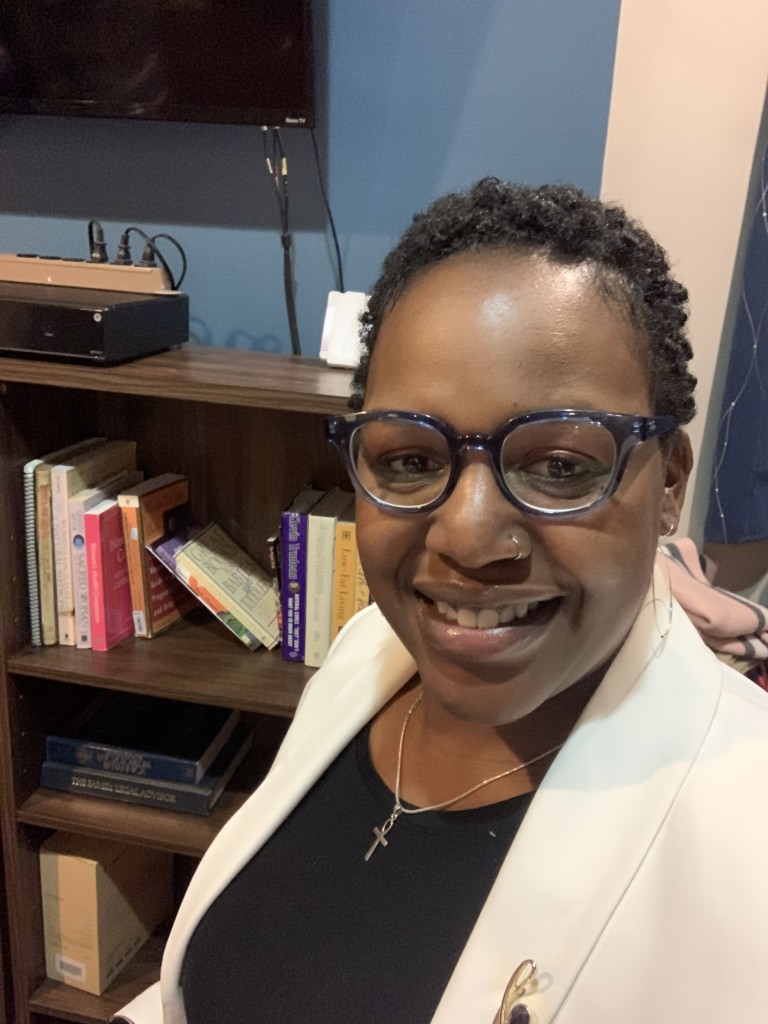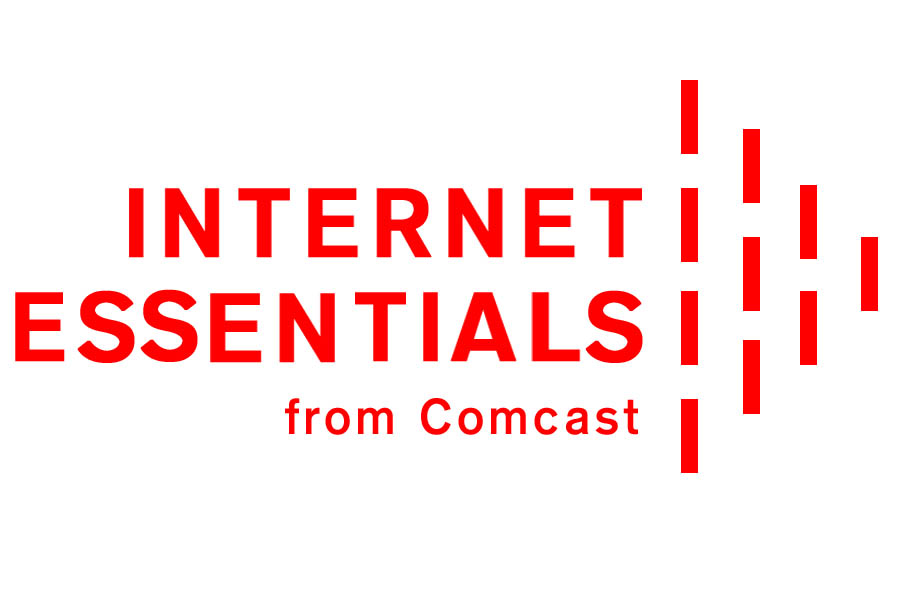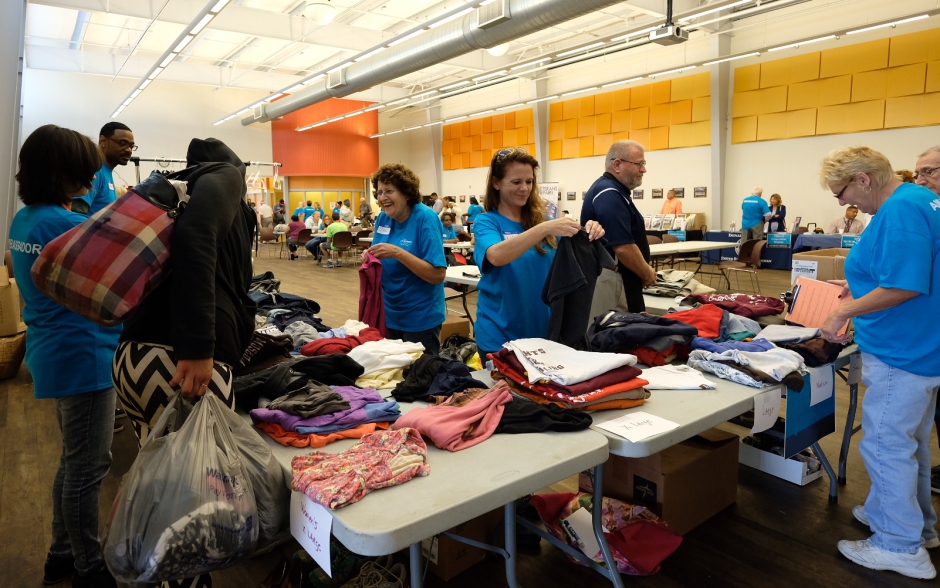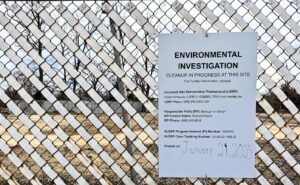For a city that has been defined by its cyclical poverty, public, local, broadband Internet service could be a potential solution for its digital divide, while spurring on a healthy economy and democracy.
By Katrina Janco | April 27, 2021

Hopeworks teaches digital literacy and technology skills to young adults in Camden City. Credit: Hopeworks.
Although the digital divide has existed at least as long as commercially available Internet has, the novel coronavirus (COVID-19) pandemic has underscored the persistence of the problem for swaths of vulnerable New Jerseyan
The digital divide, as defined by Stanford University, “refers to the growing gap between the underprivileged members of society, especially the poor, rural, elderly, and handicapped portion of the population who do not have access to computers or the Internet; and the wealthy, middle-class, and young Americans living in urban and suburban areas who have access.”
In Camden County, conditions in the Camden City School District offered a local illustration of the depth of this division at the outset of the pandemic.
At that time, as district Superintendent Katrina McCombs noted in a March 2020 op-ed in the Courier-Post, just 30 percent of the 6,800 children in the Camden City School District (2,040 students) had the necessary tools—both an Internet connection and a web-enabled device—for remote learning.
Lack of Internet access throughout Camden City is itself a significant problem. According to an October 2020 report by the Delaware Valley Regional Planning Commission (DVRPC), broadband subscriptions rates in the city ranged from 40 to 60 percent, as compared with the 80-percent average of rates across Camden County itself and the Greater Philadelphia region.
Camden City has the physical telecommunications infrastructure to support broadband Internet access, and various providers serve its market. Cost to access these services, however, has been a significant barrier, followed closely by quality of service.
Some residents have complained about signal strength issues in various neighborhoods throughout the city. Camden City native and activist Ronsha Dickerson said that in her experience, even families who purchase premium service plans failed to get broadband speeds.
“If you have three or more people inside your home, you’re going to struggle with Wi-Fi,” Dickerson said. Some families use their cellular phones as hotspots; others have relied upon mobile hotspots provided to students by the school district.
From the perspective of the city government, a variety of initiatives have been undertaken to resolve the issue.
Camden City spokesman Vince Basara said the city and its public- and private-sector partners continue to work collectively to close its digital divide.
They’ve taken advantage of federal initiatives, such as the ConnectHome program, which provides low-cost Internet service for residents living in public housing.
The city has also received donations from private entities in the form of digital devices, Internet service, digital literacy coursework, and educational resources, he said.
“Obviously, digital inclusion is critical as access to [the] Internet and digital services have become a daily essential,” Basara said.
“Through [these] ongoing [partnerships], we want to ensure everyone in Camden, regardless of background, income or zip code, has an equal opportunity to obtain access to these services.”
Even the plan for the Camden County Municipal Authority (CCMUA) microgrid, which would keep critical utility systems running in the event of an environmental disaster, contemplates running 5G Wi-Fi service parallel to its processes. Most low-income families currently do not own 5G devices, yet access to the service is important for building future capacity
Current options, competing interests
At the federal level, the U.S. Federal Communications Commission (FCC) offers Lifeline, a low-cost broadband service that’s subsidized by the Universal Service Fund fees broadband subscribers pay on their monthly bills. However, Lifeline has been criticized for failing to provide minimum service standards, and customer eligibility for the service is determined by its providers, which creates inherent conflicts of interest.
Among the most promising options for Camden City residents is Philadelphia-based Comcast, which provides its Internet Essentials broadband package for less than $10 per month, using qualifications for federal benefits like SNAP and the National School Lunch Program as its eligibility benchmarks.
Since the launch of Internet Essentials in 2011, more than 276,000 New Jersey residents, including 64,000 in Camden County, have connected to the Internet through the program, according to Comcast PR manager Alexandra Wachman.
Comcast has also partnered with Camden City-based organizations like Hopeworks, the Center for Family Services, LUCY Outreach, and the Camden City School District to close the digital divide.
The Boys and Girls Club of Camden is also a Comcast “Lift Zone,” which offers free hotspot connectivity to help students participate in distance learning through such community groups.
In March 2021, Comcast promised to invest $1 billion in a “digital equity pledge” that will further support Internet Essentials, Lift Zones, and nonprofit community groups that support low-income residents—including those in Camden City.
Since the 1990s, corporations like Comcast have been the primary builders of fiber, broadband and other telecommunications infrastructure, especially in urban areas. This has been promoted by public policy, most notably the Telecommunications Act of 1996, and subsequent court decisions further defining the Act.
Despite the promises of technology being a great social equalizer, disparities persist nearly three decades later, leading industry experts like Christopher Mitchell, director of the Community Broadband Networks Initiative, a project from the Washington, D.C.-headquartered Institute for Local Self-Reliance, to conclude that “it is foolish to think the private sector alone can solve these infrastructure challenges.
“Private companies building networks may be useful for many areas, but we need nonprofit business models to serve some parts of the country,” he said. “We need multiple models.”
Dr. Burcu Baykurt, an assistant professor at the University of Massachusetts-Amherst, believes municipally hosted broadband service offers the best solution to the problem.
“[The digital divide] became a problem because it was framed to be a technical problem,” Baykurt said. “By declaring it as a technical problem, we intentionally obfuscated the political and economic decisions underlying the reasons why there is a divide.”

Burcu Baykurt, assistant professor of Urban Futures and Communication at the University of Massachusetts Amherst and faculty associate at the Berkman Klein Center for Internet & Society at Harvard University. Credit: Burcu Baykurt.
Offering broadband Internet access as a municipal service threatens the revenues of Internet Service Providers (ISPs), which would rather capture low-end market share by framing its basic packages as philanthropic exercises.
At the same time, however, the largest ISPs have spent millions on lobbying efforts to oppose municipal broadband, which they argue are unfair competition.
Such corporations would rather see public dollars subsidize the expansion of their networks into underserved communities, rather than creating a parallel infratructure.
NCTA – The Internet and Television Association, of which Comcast is a member, is one of the largest such lobbying groups.
In public comments responding to the White House Infrastructure Plan released in March 2021, NCTA has argued that creating municipal broadband networks “mistakenly lump[s] in our successful modern digital networks with our decaying roads, bridges, waterways and electric grids.
“Government does have a critical role to play in getting networks to areas that lack service and helping low-income families afford it. However, those targeted, shared goals are not served by suggesting wrongly that the entire network is ailing and that the solution is either to prioritize government-owned networks or micromanage private networks, including the unfounded assertion that the government should be managing prices,” NCTA President and CEO Michael Powell wrote.
Regulatory approaches
The New Jersey state legislature is currently contemplating several bills that would plan or study the question of municipal broadband.
A850 would establish a Broadband Access Study Commission to measure the feasibility of deploying high-speed networks in parts of the state that lack them. That bill has passed both the Assembly and the Senate, and now waits on Governor Murphy’s desk. Assemblymen Bill Moen (D, NJ-05) and William Spearman (D, NJ-05), who both represent Camden City, voted for the bill; Moen co-sponsored it.
In late October, the New Jersey state assembly passed AR92, a resolution urging the U.S. Congress to pass the Community Broadband Act of 2019, which would allow states and local entities to provide broadband. Assemblymen Moen and Spearman supported the resolution. SR98, a companion resolution introduced to the New Jersey state senate in November 2020, was referred to the Senate Economic Growth committee, and remains there.
S2900, which would require the New Jersey Office of Information Technology to establish a statewide wireless network through a public-private partnership agreement, was introduced into the New Jersey state Senate in September, and is still in the Senate Economic Growth committee.
That committee is chaired by New Jersey State Senator Nilsa Cruz-Perez (D, NJ-05), who represents Camden City. Her office did not respond to e-mail requests asking for the senator’s position on SR98 and S2900.
Nationally, U.S. Senator Cory Booker (D, NJ) introduced the U.S. Senate version of the same bill last year; Steven Sandberg, press secretary for U.S. Senator Bob Menendez (D, NJ), said Menendez is still reviewing the bill.

The Camden Dream Center helps school-aged children to learn technological skills. Credit: Camden Dream Center.
Community benefits and real-world examples
A municipal broadband service would mean the overburdened Camden City School District has one less thing to worry about.
It’s also a much more sustainable option as compared with issuing hotspots, which is what the district has been doing to overcome its students’ access issues.
“Hotspots are the opposite of sustainable,” Mitchell said.
“They require someone to buy them every year, and as soon as the funding is gone, there is nothing for low-income families.
“Municipal broadband may require a greater [amount] of spending in the first year than the hotspots, but a well-designed approach will either not require ongoing appropriations or will require a minimal amount,” he said.
“When the subsidies end, a [municipal broadband] system would be able to continue generating benefits because it is generating revenue from subscribers that can keep the system going,” Mitchell said.
Reliable broadband infrastructure is also critical for future job growth in Camden City. EPB in Chattanooga, Tennessee, perhaps the most successful municipal broadband network in the country, has generated over $2.69 billion since its creation a decade ago. Those economic benefits include job creation and retention, attracting entrepreneurship, and bridging the digital divide in schools.
EPB isn’t the only example, either. Currently, hundreds of communities across America enjoy municipal broadband service.
“There are actual, really good, well-functioning examples in the United States,” Baykurt said. “So it is not just an ‘Oh, it might work in other countries, but not here’ kind of idea.”
A prime example of a successful municipal broadband network exists in Newark, New Jersey, where Newark Fiber provides low-cost, high-speed Internet connections, in participating residential and commercial buildings, parks, on the streets, and recreational centers. Having launched in November 2016 as a division of the development agency Invest Newark, its model has enjoyed significant positive response from the community.
“The only time we’ve had any negative feedback is when maybe the system went down because someone drove into the traffic box down the street,” said Vanessa Quijano, Senior Vice-President of Business Development of Invest Newark.
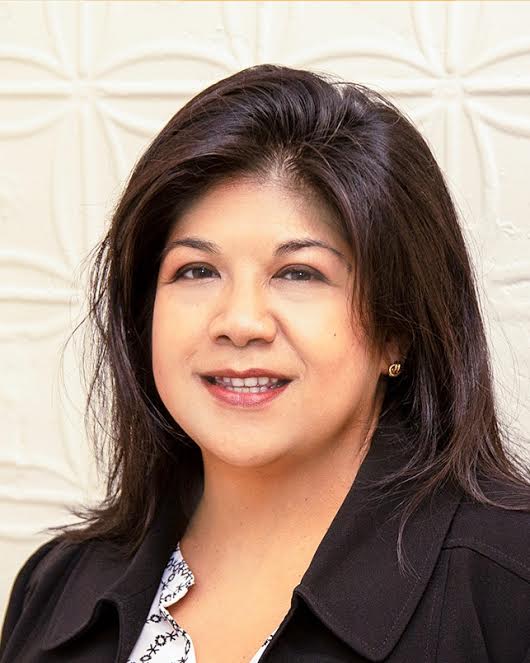
Vanessa Quijano, Senior Vice President, Business Development – Invest Newark. Credit: Vanessa Quijano.
Mitchell praised Newark Fiber’s roll-out model.
Building from initial partnerships with public safety and municipal agencies, the network grew to pilot a program to provide free service for residents in low-income housing developments.
“They had a very smart initial approach: to use low-risk investments to bring high-quality access at very reasonable prices to commercial and residential high-density facilities,” Mitchell said.
Newark Fiber also has been used as a selling point to entice new businesses and residents to come to the city.
“Especially with COVID, as people are working from home, getting one-gig [Internet speeds] so that your whole family can now work from home, homeschool, [or] watch all your Netflix, the higher bandwidth and reliable service is definitely a selling point,” Quijano said.
In addition to drawing in new citizens and supporting those who already reside there, a high-speed municipal broadband network invites broader community participation, Baykurt said.
“By having municipal broadband, you’ve communicated to the residents that they have a say in those networks, and how they are used and distributed,” she said. “It is definitely more empowering than leaving to private companies to determine what is affordable, and what is not.”
This is especially important in Camden, where many residents already feel that their leaders don’t acknowledge their longtime concerns.
“There’s been an image of Camden moving forward, because you see so [many] businesses coming to certain areas of Camden,” Dickerson said. “But I want to make it crystal clear, that we, the residents that live in the city, do not feel Camden [is] moving forward.
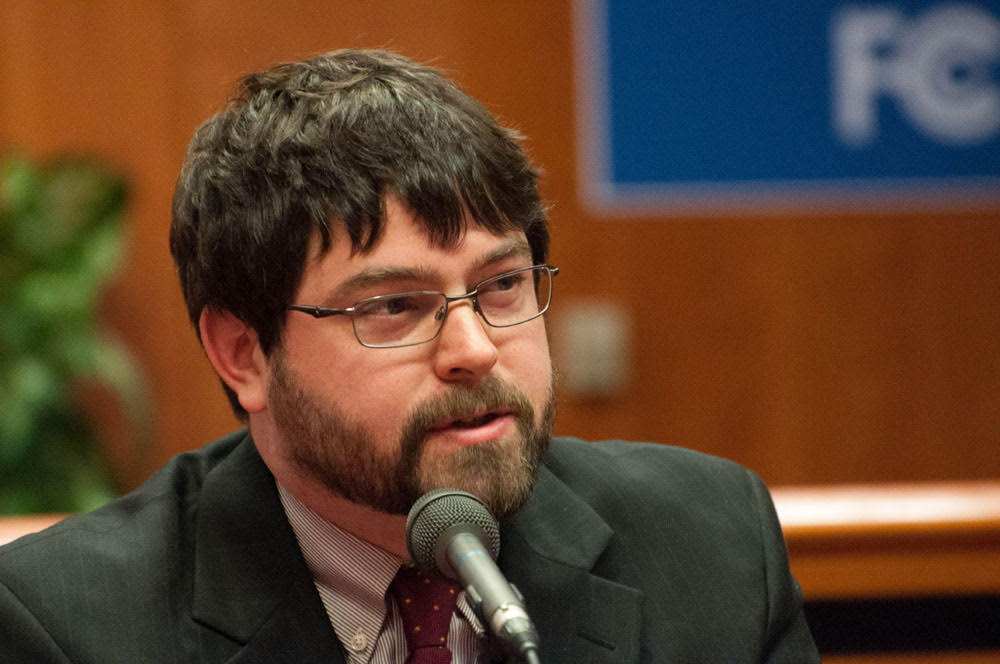
Christopher Mitchell, Director of the Community Broadband Networks Initiative with the Institute for Local Self-Reliance (ILSR) in Minneapolis. Credit: Glenn Ricart.
“There’s a culture in Camden, where people who are in political office, people who are decision-makers for the city, make decisions without inclusive participation from its residents,” she said.
“There’s a culture of political games that are being played on the residents’ backs.”
Mitchell said that building a municipal broadband network could be an opportunity to help solve this problem.
“When done correctly, it can really build faith in the ability of local governments to solve the problems people want solved,” he said.
Getting to that stage requires careful planning, however.
“Sometimes people latch onto municipal broadband as this idea of, ‘Oh, we can solve everything,’” Mitchell said.
“And over five or ten years, municipal broadband can do wonders. But it takes a lot of work, and there are things that can go wrong along the way, that would actually make the city worse off, if it spends a bunch of money that is ineffective,” he said.
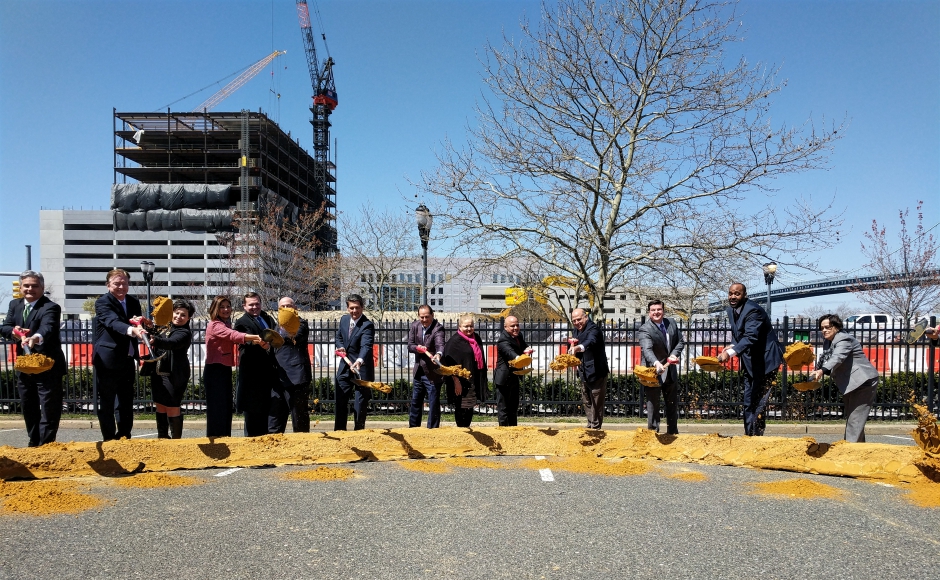
Elected officials and development partners toss ceremonial shovelsful of dirt at the 11 Cooper groundbreaking in Camden. Credit: Matt Skoufalos.
Starting up
If Camden City were to contemplate rolling out a municipal broadband network, Mitchell recommends an incremental approach with targeted short-term goals to avoid compounding any mistakes, especially since 35 to 40 percent of residents would need to adopt the service in the first few years in order for it to pay for itself.
Targeting high-density areas, such apartment buildings and public housing facilities, would be great places to start, he said: there, a city can make reasonable investments and bring hundreds of families online at a time. Such a roll-out hinges on identifying community needs; however, data on broadband is often either old, incredibly imprecise, or both.
DVRPC senior planner Spencer Gober, who wrote the commission’s 2020 broadband reports, noted that the most current U.S. Census data he was working with to do so dated back to 2017.
“We’re doing our best to plan in the current circumstances with data that is already three years old,” Gober said.
FCC data on coverage areas and speeds comes from ISPs twice a year; however, the agency has been criticized for dramatically overstating the level of internet access on its broadband map. According to a 2019 report from the Associated Press, “the commission considers an entire area covered if a service provider reports that a single location on a census block has or could have fast internet speeds.”
This is particularly worrisome, as federal funding, which could help pay for a municipal broadband network, depends on good data.
“The more accurate data [the federal government has], the better they can prioritize funding and attention to the areas that need it most,” said Kimberley Irby, a policy analyst with New Jersey Future of Trenton.
Irby said New Jersey should establish an office dedicated to providing grants and data collection on broadband usage across the state in order to gather more granular and accurate data. New Jersey did collect state broadband as recently as 2012, but that program ended in 2015, along with the federal funding that had supported it.
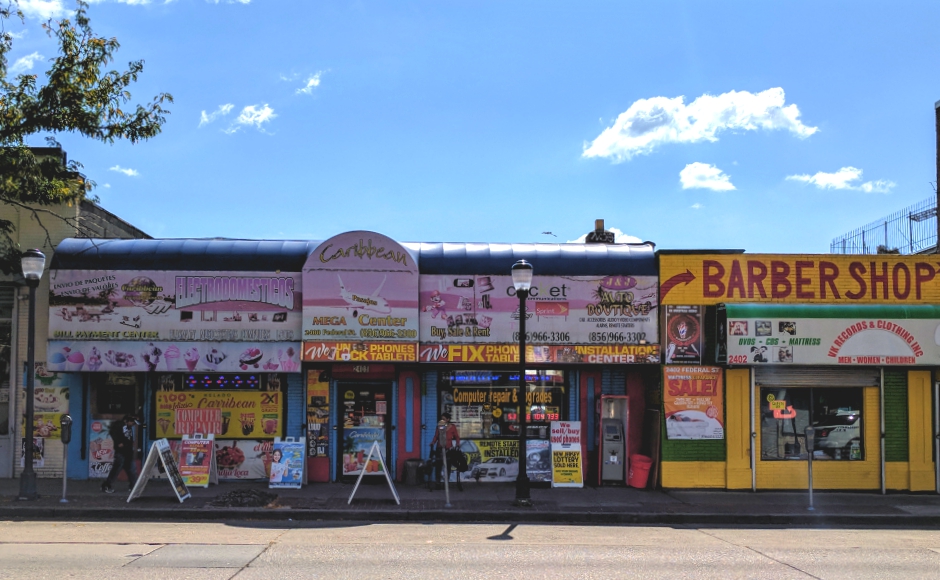
Federal Street in East Camden is one designated area of the city that will be eligible for EDA small business grants. Credit: Matt Skoufalos.
Any planning for a municipal broadband network also would require an understanding of the city’s infrastructure, Quijano said.
This is true whether the model would be fiber, Wi-Fi, or another technology.
“If all the buildings are low, you’re not going to get the height for the Wi-Fi,” she said.
“[If], instead of a 100-floor tower, you’re putting it on five-floor buildings, you’re going to have to put [in] more [devices],” Quijano.
Newark was fortunate to already have so much fiber backbone. After the September 11, 2001 terrorist attacks on New York, Newark disconnected its “dark,” or unused fiber, to ensure greater reliability of its municipal services. Many businesses from New York City also moved to Newark at that time, to take advantage of new commercial developments and cheaper rents, and the city installed additional fiber to meet those needs.
Newark CEDC, the predecessor organization to Invest Newark, began directly leasing fiber from the city, and partnered with Gigxero, a network servicing company, to create the network. Invest Newark will likely bring on additional partners to grow the program at the speed they want to, Quijano said.
Cities also need the engineering knowledge to offer municipal broadband, Quijano said, noting that Newark Fiber has faced IT support and staffing challenges related to this knowledge gap.
Who pays?
When it comes to implementing municipal broadband, one of the biggest hurdles to overcome is cost, and who’ll be paying for it.
According to Mitchell, given Camden’s population, the general ballpark for building a municipal broadband network could range from $60 to $70 million; at the outliers, it could also hit as little as $20 million or as much as $100 million.
In his experience, high operating costs, not fixed costs, kill municipal broadband projects. Wi-Fi networks are high in operating costs, while other technologies, such as the new CBRS technology being used in Tucson, Arizona, are far less expensive and don’t require multiple, large investments.
To avoid placing this burden on taxpayers, past municipal broadband initiatives have been funded in a variety of ways, including revenue bonds, federal Community Development Block Grants, and philanthropic contributions.
There’s also been dedicated federal funding for expanding broadband access as a result of the pandemic.
The two federal stimulus packages included billions in funding for broadband projects, and New Jersey used funding from the March 2020 CARES Act to bridge the digital divide in schools.
The American Rescue Plan sets aside billions for provisions that will or could cover costs associated with broadband service and devices, broadband infrastructure deployment, broadband mapping and broadband adoption.
President Joe Biden’s American Jobs Plan dedicates $100 billion to providing every American with affordable, reliable, high-speed broadband. Some of this funding does not have specific provisions, allowing states to determine how to use it.
Quijano suggested that New Jersey provide state appropriations to ensure communities can establish, maintain, and grow their network, and not make it such a heavy load for any single municipality to manage.
Although low-cost Internet can pay for itself, as it does for Newark Fiber and many other networks, studies have found that even fees of as little as $10 a month can be too expensive for some people. Beyond cost, Baykurt’s research has found that the additional paperwork associated with signing up for low-cost service, and the inflexibility of many subscription plans, have been found to be significant hurdles for residents.
“If it was free, it would be so much more helpful,” Dickerson. “It’s not that people don’t want to pay. It’s something that’s needed, and it should be offered free. But if it’s something people have to pay for, people should have options.”
“The main difference between a private company offering affordable services versus municipal free broadband is that, if you’re someone who lives from paycheck to paycheck, you don’t have to worry about whether you’re going to be able to afford the affordable service or not next month, because you know there’s always municipal broadband that is offered for free,” Baykurt said.
Many Americans already have this experience with public libraries, she added.
“Whenever you go to a public library, you know that you’ll get service,” Baykurt said. “You kind of take that for granted, and we forget how important that is when you actually need that kind of connectivity.”
Such need is particularly relevant for anyone who is evicted, or moves across town, which has been an issue for families of Camden schoolchildren. Destiny Bingham, a teacher at KIPP Cooper Norcross Academy and a Camden native, said that some students cannot get online due to unstable home conditions.
Finally, any plans for municipal broadband need community participation to develop in response to conditions there. In Baykurt’s experience, places that have had the most success with municipal broadband have had community buy-in and trust, along with funding and the staff to maintain the network. Community participation is especially important, since the digital divide is a symptom of poverty, and municipal broadband will only work if it addresses those root causes.
“I think it matters to hear what the Camden community needs in terms of access,” Baykurt said. “We need to really look at, ‘Okay, what does that community need?’”
This story was produced thanks to a reporting grant facilitated by the Center for Cooperative Media at Montclair State University and funded by New Jersey Children’s Foundation.


